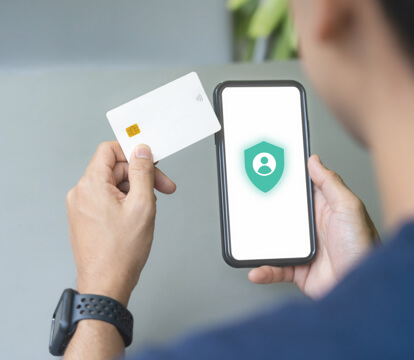Protect Your Identity With ID Protection by AOL

What is ID Protection by AOL?
AOL has partnered with the best in the identity protection business, bundling multiple top-of-the-line services like LifeLock identity theft protection to help provide an all-in-one comprehensive approach to keeping your identity safer.
Easily store all your passwords in one safe place for instant access—no more forgotten passwords!

LifeLock proactively scours over a trillion data points daily.1
Monitors photos, videos, blogs and more for any reference to you and your family.
24-hour monitoring of your address, phone number and more across the web.

Why AOL?
AOL has been online for over 30 years - we've seen the dangers and know how to help protect you when it comes to your online security.
We strongly believe that in today's world of growing identity threats, one single identity solution isn't enough.
Not just for AOL members, ID Protection by AOL was created to provide comprehensive identity protection for people like you both online and off.
Using the partnerships we have established over the years with industry-leading identity protection experts, we put together a plan that bundles top-of-the-line security and identity theft protection services that goes above and beyond just protecting you from one aspect of identity theft.
ID Protection by AOL works around the clock to help guard your online reputation and secure your usernames, passwords and personal information; all for only $11.99/month, a much lower cost than paying for these services separately or recovering from identity theft.
How you’ll be protected
Identity theft is a growing threat. You may be exposed in more ways than you think.
Credit card fraud
Identity thieves can use your personal information to open new credit card accounts, make fraudulent charges and more.
Vulnerable passwords
When you use the same password across numerous websites or make other password mistakes, your information becomes more vulnerable to identity thieves.
Identity fraud
Your home address and other personal information from the web can make you a target for identity thieves.
Negative online posts
It’s hard to keep up with what others say and post about you online, with potentially negative comments and reviews that may damage your online reputation.
Solution: LifeLock® Identity Theft Protection monitors for fraudulent credit card applications and false address changes in your name and alerts you by text, phone or email if anything is found
Solution: LastPass Premium creates long, random passwords and keeps track of them, protecting you from hackers
Solution: MyPrivacy© stops people-search sites from exposing your data online, including your address, phone number and birth date
Solution: MyReputation Discovery® conducts a comprehensive search of the deep web to find your personal information and posts all findings on your personalized dashboard
Get ID Protection by AOL today
What is Identity Theft?
Defining identity theft: Identity theft is a criminal activity where someone illicitly acquires your personal information, such as your name, social security number or financial details, with the intention of impersonating you. This can cause harm to your financial and personal well-being. Are your online activities putting you at risk for identity theft?
Types of identity theft
-
Occurs when an individual gains unauthorized access to your financial information, like bank account numbers or credit card data. This information is then misused for unauthorized transactions or fraudulent account openings. It can result in financial losses and credit score damage.
-
When someone wrongfully obtains your medical details, including health insurance information and medical history. This stolen data is often used for obtaining medical services or making false insurance claims, which can pose challenges to your health and finances.
-
Involves the misuse of your identity during the commission of criminal activities. This may include providing false identification to law enforcement, potentially leading to mistaken arrests or charges against you. The legal and social consequences can be significant.
-
A more complex form of identity theft where a perpetrator creates a fabricated identity by mixing real and fake information. These synthetic identities are often used for obtaining credit cards, loans, or other financial services, making it challenging for authorities to detect and prevent such fraud.
How identity theft occurs
Identity theft can occur through various methods, and understanding these avenues is critical for safeguarding your personal information.
-
Involve deceptive emails, messages or websites designed to trick you into divulging sensitive information, such as login credentials or financial details. These fraudulent communications often impersonate trusted entities, like banks or government agencies, and request personal information or direct recipients to malicious websites. Falling for these scams can result in unauthorized access to your personal data.
-
Occur when cybercriminals gain unauthorized access to an organization's database or network, compromising the personal information of individuals associated with that organization. In some cases, these breaches can expose sensitive data, including names, addresses, social security numbers, and financial records. Hackers can use this stolen information for identity theft purposes.
-
Identity thieves frequently employ social engineering techniques to manipulate you into revealing personal information. This can involve tactics such as pretending to be a trusted friend or family member, or impersonating an authoritative figure over the phone. By building trust or fear, the attacker convinces victims to share confidential data willingly.
-
Identity theft can also occur through physical means. Criminals may steal wallets, purses or documents containing personal information, such as driver's licenses, social security cards or credit cards. Losing such items or having them stolen can expose you to identity theft risks, as the thief gains access to critical identifying details.